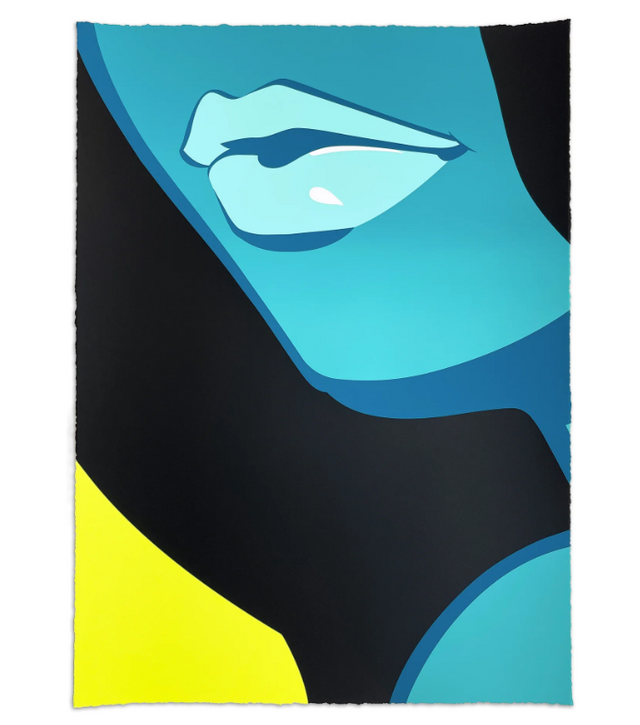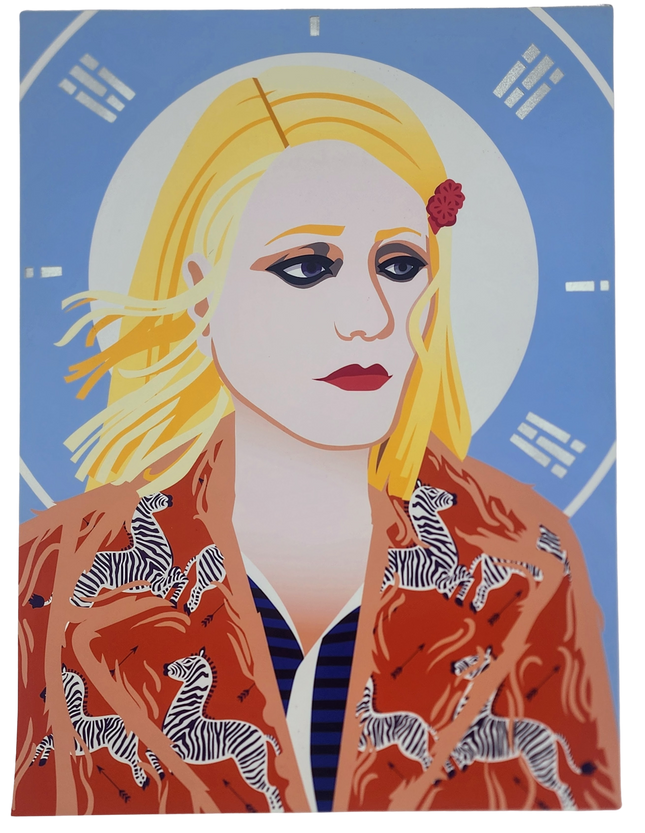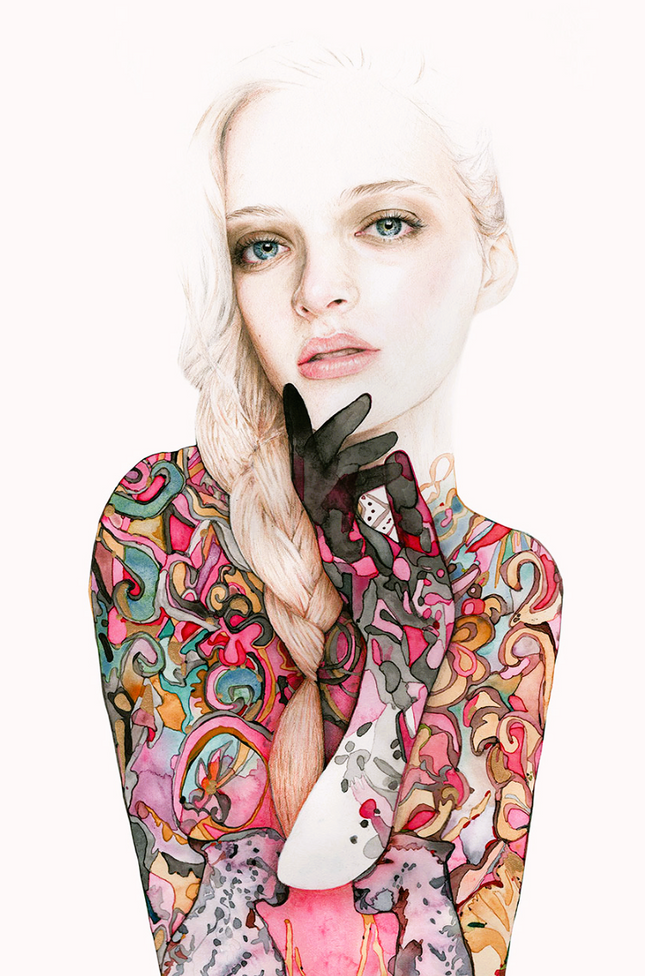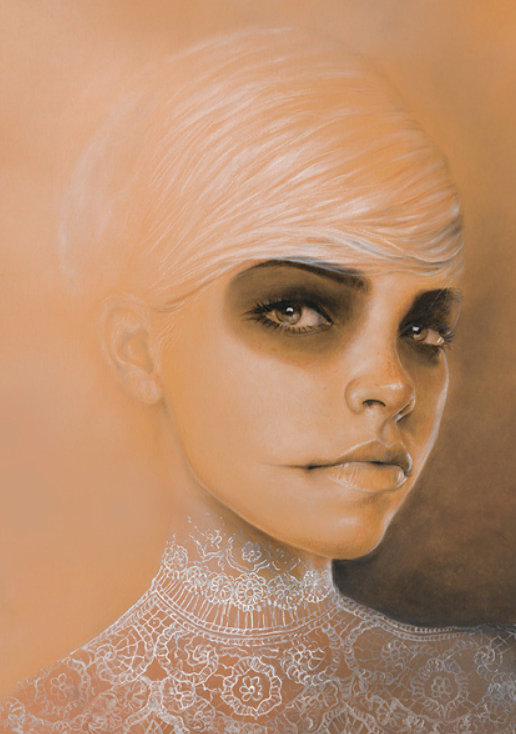
Hair

Kevin Stanton Margot Silver Hand Cut HPM Giclee Print by Kevin Stanton
Margot Silver Hand Cut HPM Spray Paint Giclee Print by Kevin Stanton Artwork Limited Edition Print on Layered Glitter Fine Art Paper Hand Embellished Print Graffiti Pop Street Artist. 2013 Signed & Numbered Spray Paint Glitter Paper Hand Cut Embellished Limited Edition #1 of 4 Artwork Size 11.75x15.75 HPM Giclee Print. Silver Paper Collage of the Woman Gwyneth Paltrow as Margot Tenenbaum Stylized from the Movie The Royal Tenenbaums. Kevin Stanton's "Margot Silver": An Ode to Cinematic Iconography The "Margot Silver" hand-cut HPM (hand-painted multiple) Giclee print is a masterful creation by Kevin Stanton, a renowned Graffiti Pop Street Art figure. This piece is exceptional as a limited edition work, being the first in a series of four, each meticulously signed and numbered by the artist. The artwork, sized 11.75x15.75 inches, is a silver paper collage on layered glitter fine art paper, which has been hand-embellished to enhance its visual appeal. Stanton's piece pays homage to Gwyneth Paltrow's character, Margot Tenenbaum, from Wes Anderson's critically acclaimed film "The Royal Tenenbaums." Interplay of Film and Street Art Aesthetics Stanton's "Margot Silver" is a prime example of how the realms of pop culture and street art can intertwine to produce work that is both referential and original. The piece takes a character made famous in cinema and reinterprets her through the lens of street art, employing techniques like spray paint, which are traditionally associated with graffiti. The result is a bold, graphic portrayal that captures the essence of Margot Tenenbaum's character through stylized form and color, resonating with the vibrancy and immediacy found in Street Pop Art. This print is more than a representation of a film character; it is a dialogue with the audience, inviting them to revisit the familiar in a new light. Just as street art often repurposes public spaces to create something that commands attention and sparks conversation, Stanton's work repurposes the image of a well-known figure, encouraging viewers to engage with the character and the art on a deeper level. Craftsmanship in Contemporary Art In "Margot Silver," the craftsmanship is evident in the precise cuts and the thoughtful application of embellishments, which bring the piece to life. Using glitter paper adds a textural dimension that contrasts with the flatness often associated with spray paint, demonstrating Stanton's skill in marrying disparate elements to create harmony on the canvas. The work reflects a broader movement in contemporary art that sees artists bringing traditional techniques into the conversation with modern themes and mediums. Stanton's approach to his craft, particularly the intricate cut-paper method, echoes the meticulousness of street artists who spend hours perfecting their murals and stencils. His limited edition print, much like a carefully curated mural, becomes a landmark in the landscape of contemporary art—a marker of creativity and ingenuity. The Lasting Impact of "Margot Silver" Kevin Stanton's "Margot Silver" symbolizes the artist's dedication to pushing the boundaries of street-inspired art. By choosing to immortalize a cinematic character through the methods and mediums of street art, Stanton not only pays tribute to the character and the power of visual storytelling. His work stands as a reminder that the essence of street pop art and graffiti art lies in its ability to transform the familiar into something extraordinary, to imbue the everyday with significance and beauty. The print remains a captivating piece within Stanton's oeuvre, a testament to his ability to navigate and transcend the realms of street and pop art. As the art world continues to evolve, works like "Margot Silver" prove the enduring spirit of innovation that drives artists like Kevin Stanton to create pieces that are both of the moment and timeless.
$175.00

Bec Winnel Candy Giclee Print by Bec Winnel
Candy Giclee Print by Bec Winnel Artwork Limited Edition Print on Fine Art Paper Graffiti Pop Street Artist. 2014 Signed & Numbered Limited Edition of 25 Artwork Size 11.75x16.25 Colorful Tattooed Young Blond Woman in Thought. Exploring the Fusion of Femininity and Street Pop Art in Bec Winnel's Candy Giclee Print Bec Winnel is a name that resonates deeply in contemporary art, particularly within Street Pop Art and Graffiti Artwork. This Australian artist has become known for her meticulous and delicate approach to portraiture that marries traditional drawing with contemporary themes and street art sensibilities. One of Winnel's standout pieces is the 'Candy Giclee Print,' a limited edition artwork that showcases her unique blend of these artistic styles. Limited to 25 prints, each piece is hand-signed and numbered by the artist, making it a coveted item for collectors and enthusiasts of Street Pop Art. The Allure of Limited Edition Art The 'Candy Giclee Print' measures 11.75x16.25 inches, a size that is intimate yet commanding. The choice of fine art paper as a medium for this print adds to the allure, providing a tactile quality that elevates the viewing experience. Limited edition prints such as this offer a sense of exclusivity and investment, promising that only a select few can own a piece of this visual narrative. The rarity of the edition often incites a deeper appreciation and a connection with the artwork, further intensified by the artist's personal touch in her signature. Symbolism and Style in Candy Giclee Print The artwork is an evocative portrayal of a young blond woman tattooed and lost in thought. The colors are vibrant, with the tattoo patterns reminiscent of graffiti art. This melding of styles is particularly effective in conveying the personality and inner life of the subject. The tattoos, which could be perceived as a form of street art, adorn her skin like a canvas, suggesting a personal and exposed story. The subject's expression is pensive, inviting viewers to contemplate her thoughts and emotions and the cultural implications of tattoos as a form of self-expression and identity. Impact of Street Pop Art and Graffiti Artwork Street Pop Art and Graffiti Artwork have long been at the forefront of challenging traditional boundaries in the art world. They bring the vibrancy of street culture into the typically more refined gallery spaces. In the case of Bec Winnel's 'Candy Giclee Print,' there is a fusion of the delicate and the bold, the private and the public, the controlled and the free. It stands as a testament to the power of street-inspired art to infiltrate and enrich the mainstream art narrative while retaining its edge and authenticity. In the broader context of art history, pieces like 'Candy Giclee Print' are important cultural artifacts that reflect the times and social attitudes. They also underscore the significance of street art in contemporary dialogues about art and its place in society. Winnel's, with its intricate detail and emotional depth, exemplifies how the medium of street art can be as potent and profound as any traditional art form, capable of conveying complex themes and resonating on a deeply personal level with viewers. Through her work, Bec Winnel contributes to the growing recognition of Street Pop Art as a legitimate and essential form of artistic expression. Her pieces do not just hang on the walls of those who purchase them; they hang in the collective consciousness of a society increasingly acknowledging the blurred lines between high art and street art, between the gallery and the alleyway. Winnel's 'Candy Giclee Print' is not just a beautiful piece of art; it is a piece of cultural dialogue, a slice of contemporary life, and a reflection of the evolving landscape of art and expression.
$225.00

Bec Winnel Grace Giclee Print by Bec Winnel
Grace Giclee Print by Bec Winnel Artwork Limited Edition Print on Fine Art Paper Graffiti Pop Street Artist. 2014 Signed & Numbered Limited Edition of 25 Artwork Size 11.75x16.5 Stylized Tribal Geometric Tattooed Young Woman in Thought. Grace Giclee Print: A Confluence of Introspection and Street Pop Art The 'Grace Giclee Print' by Bec Winnel is a remarkable testament to the artist's ability to convey deep introspection through Street Pop Art and Graffiti Artwork. This limited edition print, restricted to a count of only 25, captures the essence of contemporary art's dialogue with traditional forms of expression. Each print, measuring 11.75x16.25 inches, is meticulously signed and numbered by Winnel, asserting its authenticity and value in the art market. Bec Winnel's Artistic Journey and Signature Style Bec Winnel, an Australian artist, has steadily etched her name into the global art scene with her distinctive approach to Street Pop Art. The 'Grace Giclee Print' exemplifies Winnel's signature style, often featuring young women adorned with stylized tattoos with tribal and geometric aesthetics. Similar to graffiti, these tattoos act as symbolic armor, representing resilience and vulnerability. They serve as a visual bridge between the subject's inner world and the outer reality, a theme prevalent in Winnel's body of work. Her ability to encapsulate complex emotional states through such imagery makes her work resonate with a diverse audience. Understanding the Essence of Street Pop Art and Graffiti Artwork The 'Grace Giclee Print' is not merely an object of beauty but a narrative piece that speaks volumes about the intricacies of human expression. Winnel's work is a canvas where the personal and the universal meet, much like the ethos of Street Pop Art and Graffiti Artwork. These art forms, traditionally seen on public platforms, are recontextualized in Winnel's work to explore the private contemplations of the individual. This juxtaposition invites viewers to reflect on the interplay between public exhibitionism and private introspection, a dynamic central to understanding street art's influence on contemporary culture. The Cultural Significance of Limited Edition Artworks Limited edition prints such as 'Grace Giclee Print' hold a special place in the art world due to their exclusivity and the connection they forge between the artist and the collector. The scarcity of such artworks elevates their desirability and, by extension, their potential as cultural artifacts. Winnel's choice to limit the print run to 25 pieces adds an element of urgency and prestige to the acquisition of 'Grace,' making each print a cherished possession for those fortunate enough to own one. Beyond their aesthetic appeal, limited edition prints like this one symbolize the ongoing evolution of street art as they continue to permeate the more formal realms of art collection and critique. The 'Grace Giclee Print' by Bec Winnel is a compelling representation of the fusion between traditional portraiture and Street Pop Art's raw, expressive power. Winnel's dedication to her craft and ability to distill complex emotions into her artwork ensure that her pieces are visually stunning and intellectually and emotionally stimulating. The limited edition nature of 'Grace' adds to its mystique, promising to hold a place of honor in the annals of contemporary Street Pop Art and Graffiti Artwork.
$225.00




